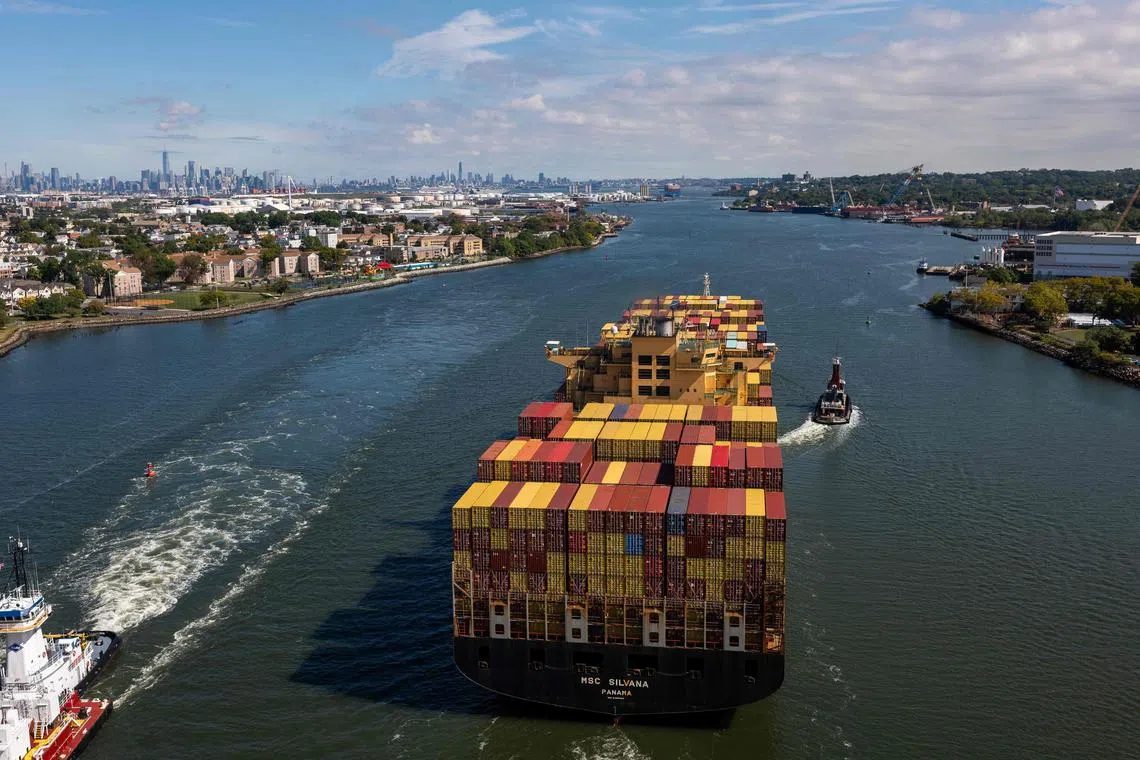US East Coast dock workers strike, in blow to shipping imports and exports
Sign up now: Get ST's newsletters delivered to your inbox

A container ship leaving the Port of Newark for the Atlantic Ocean on Sept 30, seen from New York City.
PHOTO: AFP
Follow topic:
NEW YORK – Dock workers along the US East Coast and Gulf Coast began a strike on Oct 1, halting the flow of about half the nation’s ocean shipping after negotiations for a new labour contract broke down over wages.
The strike blocks everything from food to vehicle shipments across dozens of ports from Maine to Texas, in a disruption analysts warned will cost the economy billions of dollars a day, threaten jobs and stoke inflation.
The International Longshoremen’s Association (ILA) union, representing 45,000 port workers, had been negotiating with the United States Maritime Alliance (USMX) employer group for a new six-year contract ahead of a midnight Sept 30 deadline.
“As a result of the expiration of the master agreement between United States Maritime Alliance and the International Longshoremen’s Association, there is a work stoppage at the Port of Virginia and other ports along the US East and Gulf coasts,” the Virginia port authority said, announcing the stoppage.
The USMX and union did not immediately respond to requests for comment.
But the ILA’s fiery leader, Mr Harold Daggett, said earlier employers like container ship operator Maersk and its APM Terminals North America had not offered appropriate wage increases or agreed to demands to stop port automation projects. The USMX said in a statement on Sept 30 it had offered to raise wages by nearly 50 per cent.
The ILA said in statements on Sept 29 and 30 that a port strike would go ahead, starting on Oct 2 at 12.01am.
The strike, the ILA’s first since 1977, is worrying businesses across the economy that rely on ocean shipping to export their wares or secure crucial imports. The strike affects 36 ports that handle a range of containerised goods from bananas to clothing to cars.
The union is “holding the entire country over a barrel”, said Mr Steve Hughes, chief executive of HCS International, which specialises in automotive sourcing and shipping. “I’m really afraid that it is going to be ugly.”
The dispute is also wedging labour-friendly US President Joe Biden into a virtual no-win position as Vice-President Kamala Harris runs a razor-tight election race against Republican former president Donald Trump.
Biden administration officials had met both USMX and ILA ahead of the strike to encourage a deal. But Mr Biden’s administration has repeatedly ruled out the use of federal powers to break a strike in the event of an impasse.
US Chamber of Commerce president Suzanne Clark urged Mr Biden on Sept 30 to reconsider, saying it “would be unconscionable to allow a contract dispute to inflict such a shock to our economy”.
Retailers accounting for about half of all container shipping volume have been busily implementing backup plans as they head into their all-important winter holiday sales season.
Many of the big players rushed in Halloween and Christmas merchandise early to avoid any strike-related disruptions, incurring extra costs to ship and store those goods.
Retail behemoth Walmart, the largest US container shipper, and membership warehouse club operator Costco say they are doing everything they can to mitigate any impact.
Port Authority executive director Rick Cotton said on Sept 30 at a news conference where New York officials sought to reassure consumers that they would not lose access to food and other essential goods. “While we have encouraged both sides to reach an amicable agreement at the bargaining table, all signs are that there will be a strike,” he said.
The contract directly affects some 25,000 ILA members at 14 large US ports, including New York/New Jersey, Boston, Philadelphia, Savannah, New Orleans and Houston.
New York Governor Kathy Hochul said on Sept 30 that the state expects no immediate impact on food suppliers or essential goods.
Media reports say the ILA is asking for a 77 per cent wage increase over six years.
USMX also said it had asked for an extension of the current contract to allow for further bargaining.
Advisory firm Oxford Economics estimated that the strike would dent US gross domestic product by $4.5 billion (S$5.78 billion) to $7.5 billion a week. The overall economic hit depends on the length of the strike, analysts say.
“A port strike would paralyse US trade and raise prices at a time when consumers and businesses are starting to feel relief from inflation,” said Ms Erin McLaughlin, senior economist at research organisation The Conference Board.
“There’s no easy Plan B. While shippers have already begun diverting some cargo to the West Coast, capacity for such alternative options are limited.”
Under the Taft-Hartley Act, President Biden has the authority to order the parties to resume talks for an 80-day “cooling off” period.
But Mr Biden said on Sept 29 he would not intervene in labour negotiations, citing his support of collective bargaining rights.
Time to stockpile?
At the news conference on Sept 30, New York officials emphasised that they have been preparing for a likely strike.
“We don’t anticipate shortages of essential goods any time soon,” Ms Hochul said. “People do not need to rush out to the grocery store and stockpile goods like they did during the pandemic.”
She noted that pharmaceutical products will not be affected because they are typically flown in and not sent by ship. State officials are monitoring other medical supplies, but stockpiles are adequate for the foreseeable future, she said.
But she cited cars and semiconductors as items that could be affected more quickly. She also said a lengthy strike could limit availability of fresh foods such as bananas. REUTERS

